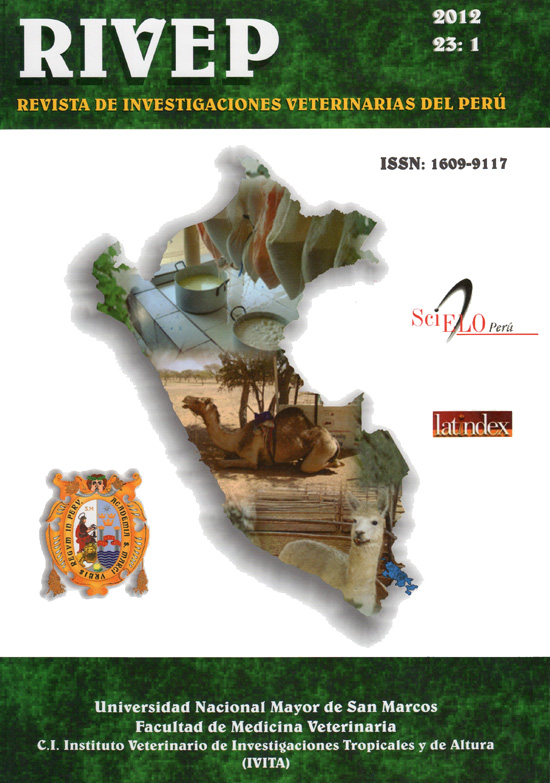Gastrointestinal helminths in sheepdogs in farmers communities of Puno, Peru
DOI:
https://doi.org/10.15381/rivep.v23i1.884Keywords:
helminthes, sheepdogs, sedimentationAbstract
The frequency of gastrointestinal helminths in sheepdogs of Ajoyani and Macusani districts in the province of Carabaya, and in the districts of Ocuvíri, Palca, Lampa, and Santa Lucía in the province of Lampa, Puno, Peru was determined. Stool samples were collected from 352 crossbreed dogs, mostly adults and apparently healthy, during January to March 2008. The coproparasitological evaluation was done by the methods of flotation with sugar solution or Sheather’s, and by the spontaneous sedimentation technique. Samples were preserved in both 10% formaldehyde and 2.5% bichromate. The resulted showed 20.5 ± 4.2% of dogs were infected with gastrointestinal helminthes. The frequency of dogs with eggs of Taenia was 14.5 ± 3.7%, Trichuris vulpis was 2.6 ± 1.7%, Capillaria sp was 0.9 ± 1%, while for Toxocara canis, Toxascaris leonina, and Ancylostoma sp was 1.4 ± 1.2% each. Besides, the frecuency of Sarcocystis sp was 9.1 ± 3%, Entamoeba coli was 16.5 ± 3.9%, and Isospora sp was 11.9 ± 3.4%. Age, sex, and agro-climatic zone were not considered risk factors for gastrointestinal parasitism. Monoparasitism occurred in 90.9% of dogs with parasite infections. Analysis of samples preserved with 10% formaldehyde or 2.5% bichromate showed similar results and therefore both substances were considered moderately consistent and mutually replaceable according to the Kappa and Mc Nemar tests.Downloads
Downloads
Published
Issue
Section
License
Copyright (c) 2012 Lilian Cruz T., Amanda Chávez V., Néstor Falcón P., Viviana Fernández P., Héctor Huamán U., Olga Li E., Wilfredo Huanca L.

This work is licensed under a Creative Commons Attribution-NonCommercial-ShareAlike 4.0 International License.
AUTHORS RETAIN THEIR RIGHTS:
a. Authors retain their trade mark rights and patent, and also on any process or procedure described in the article.
b. Authors retain their right to share, copy, distribute, perform and publicly communicate their article (eg, to place their article in an institutional repository or publish it in a book), with an acknowledgment of its initial publication in the Revista de Investigaciones Veterinarias del Perú (RIVEP).
c. Authors retain theirs right to make a subsequent publication of their work, to use the article or any part thereof (eg a compilation of his papers, lecture notes, thesis, or a book), always indicating the source of publication (the originator of the work, journal, volume, number and date).










